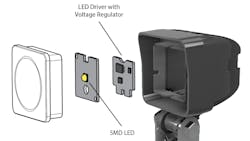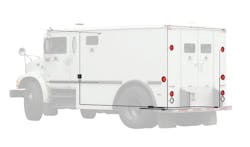An overwhelming majority of Class 8 commercial vehicles in North America operate on a 12V electrical system throughout both the tractor and trailer. In some instances, a 24V electrical system is in place. However, there is a potential shift looming in the not-so-distant future to higher voltages.
How this transition occurs is up for debate, but some would say that a gradual progression into higher voltages will occur through a combination of varying voltages throughout a single combination tractor-trailer. Though 12V systems and components are not going away anytime soon, higher voltage systems, such as 24V and 48V, may become more widely integrated and adopted as the industry pushes toward efficiency and attempts to obtain the ever-increasing and ever-present demand for more power.
Built on 12V
North American commercial vehicles on the road today, for the most part, are utilizing a 12V electrical system.
“For our current production vehicles, the electrical system is primarily supplied with electrical energy via 12V direct current (DC) lead-acid batteries, with two or more connected batteries dependent on the energy requirements for the vehicle configuration,” says Ash Makki, product marketing manager, Volvo Trucks North America, a global truck and engine manufacturer.
The electrical system contains a series of batteries to provide electrical power throughout the vehicle. The number of batteries in a series varies from vehicle-to-vehicle; vehicles equipped with electrical power units (EPUs) may have a series of up to eight batteries. EPUs are present on vehicles attempting to prevent idle time and/or have sleeper cabs with additional systems and components with electrical demands.
“Some of our commercial vehicles, mostly trucks with living (sleeper) environments, also provide an inverter that would convert the 12V DC battery energy to 110V [alternating current] (AC) for use in the living environment to provide energy to items like TVs and other conventional 110V power sockets,” Makki continues.
The electrical needs of a vehicle vary depending on the integrated components, devices, and systems present. Lighting and stereos are universally installed on all tractor-trailer combinations. However, the power needs to go beyond the truck, with added electrical demand from the trailer when connected to the tractor. The industry has proven capable of providing adequate electrical power to these various components and devices through the use of a 12V electrical system. But as more technology is introduced to the commercial vehicle, electrical power demands have increased. Though most additional technology seems to be readily integrated into a 12V system, there are other demands the industry is seeking to obtain – most commanding of which is improved fuel efficiency and reduced emissions.
As the industry seeks to create efficient internal combustion engines and minimize emissions, an opportunity presents itself to move select vehicle systems and components relying on engine-driven electrical power onto battery-supplied electrical power. Additionally, the industry will see improvements to the vehicle’s electrical system itself. With the industry seeking optimization and efficiency, it is through these opportunities that the possibility of higher voltages and multiple voltages integrated into a single vehicle be actualized into the evolving commercial vehicle’s ecosystem.
What would higher voltages deliver?
There are several reasons to support integrating higher voltages into heavy duty vehicles, the primary of which is supporting increased power demands.
“We've really matched or maximized what we can do at 12V. As we try to get more and more efficient [and] reduce emissions, some of the things the industry is wanting to do is get rid of engine-driven accessories because they are a constant drag,” says Larry Rambeaux, service application engineer, Purkeys. Purkeys, part of Mission Critical Electronics, is a commercial trucking industry electronics brand.
Rambeaux provides an example through the power steering system. A shift from hydraulic to electric power steering pumps would allow the power steering system to utilize electrical power to operate the system only when power steering is needed. This means the electrical system would deliver power to the power steering system at lower speeds and during backing the vehicle but would not use electrical power at highway speeds, whereas the hydraulic system is a constant draw on the engine.
“That [would be] a great reduction on the engine and save fuel,” Rambeaux says.
Converting systems such as power steering pumps or air conditioning compressors, for example, to electrically powered systems would greatly reduce the demand on the engine and the subsequent burning of fuel. In order to achieve that, however, the vehicle would require a higher voltage electrical system – most likely 48V.
Another major reason to push to higher voltages is the potential cost savings. Electrical systems no longer dependent on the engine’s power would not only provide fuel savings but would also help to reduce engine maintenance. Engines could potentially operate for longer intervals with fewer maintenance demands should they not have to power as many systems.
Higher voltage systems may also aid in reducing the overall weight of the vehicle. As voltage increases, current decreases. If a system went from 12V to 48V, there would be four times greater voltage; that increase in voltage would, in turn, result in one fourth less current.
“If our amperage goes way down, then we can use much smaller wiring,” Rambeaux says. “There's a lot of cost savings if you go from say, a 10-gauge wire to a 16-gauge wire, which also is a big weight savings.”
Smaller wiring can help reduce the vehicle’s overall weight. A lighter vehicle provides cost savings through aiding in improved fuel efficiency and allowing for a higher vehicle freight hauling capacity. While wiring for one system may not seem like much, an incremental weight savings may be achieved as components, devices, and systems are transitioned to higher voltages, and subsequently smaller wiring.
Furthermore, additional integration of higher-voltage components, devices, and systems are less impactful in regard to weight compared to those operating on lower voltages and heavier wiring.
“Think of the autonomous functions we're seeing or the high-speed communication functions we're seeing. These multi-voltage systems, there's a lot of benefits to having them and so there's going to be a bit of urgency to try to do it,” says Fred Kelly, director of R&D for the Americas, Prysmian Group, in regard to implementing higher and multiple voltages on a commercial vehicle. “[Higher-voltage systems] will have efficiency, will save weight, will provide more power capability, and really, fundamentally, try to help us achieve some of these fuel and emissions goals that we have as well.” The Prysmian Group manufactures electric power transmission and telecommunications cables and systems.
Optimized battery life is yet another benefit resulting from the implementation of higher voltage electrical systems.
“We can also secure more energy reservation in the batteries and as a result, reduce the alternator charging requirements that allow for less load on the engine accessory drive and improved fuel consumption,” says Makki. “With more energy reservation in the batteries, we can also improve engine startability and battery life.”
Multi-voltage vehicles
Successfully implementing multiple voltages throughout a heavy duty vehicle will require innovation in order to deliver the different, and proper, voltages to select components. For example, consider vehicle lighting. Commercial vehicle lighting supplier Optronics has designed a voltage reducer that is inside each light in order to address this need in a multi-volt environment.
“Say there are 48V coming in and the light only needs 12V to operate; it will go through a component [such as a voltage reducer] to step that voltage down to the 12V that it actually needs to run that light,” says Kyle O’Dell, director of engineering and new product development, Optronics. “Most LED lights are running off [of a] lower voltage than even 12V. So really, you're stepping the voltage down anyway … If you design a light for a 48V system, it's just like designing a light for a 12V system. You're just going to use different circuitry on the front end to get that voltage to the correct output for the LEDs to function properly.”
Currently, Optronics delivers voltage reduction capabilities in their lighting to the Australian commercial vehicle market, a market that is already operating in a multi-voltage reality with 12V and 24V systems on single vehicles throughout the country. O’Dell confirms the company is working to develop voltage reduction within their lighting capable of operating in a 12V to 48V range for the North American market.
Potential problems may arise when components are added to multi-voltage environments with varying degrees of wiring. Organizing and designating wiring throughout a multi-voltage vehicle to indicate and set aside specific voltages per wire may help to alleviate potential issues when implementing new componentry.
“One thing you need to caution people on is when they do reduce wire gauge size, they need to make sure that they're not going to add accessories to it in the future that would overload that system,” O’Dell warns. “No matter what the voltage system is, you need to be careful on your harnessing to size it properly for anything that you would add in the future as options to those vehicles.”
Another option aside from voltage reduction capability per component would be custom harnessing per vehicle. USA Harness manufactures custom power distribution centers (PDCs) to accommodate vehicles with varying voltage requirements. USA Harness is a division of Optronics.
Custom PDCs can negate the guessing game that may come with installing components into a multi-voltage vehicle. Different vehicles have varying electrical demands. O’Dell speaks to the range of electrical demands required of an armored courier and the solution USA Harness delivers in such an instance through the creation of custom PDCs.
“In the case of armored couriers, there are over 100 circuits,” O’Dell explains. “We build custom power distribution centers where we break down voltage for certain things and leave voltage higher for other components. We can tailor that design where you can have multi volts [with dedicated connection sections], where one section is a 12V [and] another section is 48V. On the PDCs for these armored cars, there are actually four different fuse block sections, so you could run on four different voltages.”
USA Harness also sees the utilization of custom PDCs viable in car carriers, heavy duty tow vehicles, and work trucks; vehicles operating with larger air compressors, additional hydraulic systems, and other electrical demands benefit from the organization custom PDCs offer. As commercial vehicles further integrate technology and electrical systems, customized PDCs may offer efficient, safe, and simple installation options. Creating designated areas of connection for varying degrees of voltage helps to navigate the installation and maintenance of electrical components and minimize the risk of issues, such as: installing components to wiring that deliver improper voltage, damaging components that do not feature voltage reduction capability should they be installed into a wire delivering too high of a voltage, overloading wiring with voltage demands, and more.
Maintenance considerations with higher voltages
When it comes to higher voltage and multi-voltage systems, the procedures, practices, and tools used in electrical maintenance will be changed to ensure safety and efficiency.
Prysmian Group’s Kelly serves as the chairman of the SAE Cable Standards Committee, as well as the chairman of the SAE Truck and Bus Electrical Systems Committee.
“At the SAE Truck and Bus Electrical Systems Committee, we are analyzing all of the old documents, reviewing what should stay 12 [volt], what should be updated to include the multi voltages, and what needs to be written that hasn't been written yet,” Kelly says. “And we're on the path. We actually developed a roadmap; we had a multi-voltage task force that was created that identified all the needs, [and] gave advice and recommendations [on] how to get there. We've taken that roadmap and we're beginning to follow it and beginning to do that work.”
Kelly is also sponsoring a proposal, titled SAE J3176.
“It's cable marking for circuit identification and multi-voltage power distribution systems … We need to communicate to the technicians clearly so that they know what they've got and how they can quickly analyze and go after repair. Part of the goal … [is] to standardize this regardless of truck brand,” Kelly says.
The proposal determines standardizing cable coloring to represent different voltage levels. Red cables would indicate 12V, yellow cables would indicate 24V, and blue cables would represent 48V. Orange cables would indicate 60V or higher, signifying high voltage. The idea is to eliminate any misinterpretation of the voltage a technician would be handling when servicing electrical wiring. The proposal also sets forth color standardization for the grounds. 12V, 24V, and 48V will have black and white-colored grounds; the differences per voltage will be indicated through striping patterns.
Kelly is also working with the Technology and Maintenance Council (TMC) to develop new Recommended Practices (RPs) for handling multi-voltage system maintenance procedures.
Purkey’s Rambeaux speaks to the TMC RPs already in place that are more important now than ever as vehicles transition into a multi-voltage environment.
“For example, in TMC, we have RP 129, which is voltage drop testing from batteries of the starter or from the alternator cables back to the battery. You can have the best battery in the world, the best [vehicle] in the world, and the best alternator in the world; if you don't have good cables, nothing's going to work right,” Rambeaux says. “Very few fleets do those tests now. If we went to 48V, we get to make those battery cables a lot smaller. It's going to become even more important because now if instead of a 2W battery cable, [you] maybe [have] a 1W cable; that is a lot less cable, and when it does get corroded, you're going to lose performance that much faster.”
With smaller wiring, the effects of corrosion become exponentially more impactful. One way to avoid corrosion issues in the wiring is through proper maintenance and testing methods. Rambeaux suggests eliminating the use of test lights when diagnosing electrical systems.
“Truck and trailer OEMs spend millions of dollars to make all this as weather-tight and weatherproof as possible, and the first time a technician stabs it, all that went out the window,” says Rambeaux, of using a test light. Instead, Rambeaux suggests relying on tools such as multimeters when diagnosing electrical wiring. However, more training on electrical systems and the proper use of multimeters is paramount.
“Two years ago, our station at TMC for SuperTech, had 100 of the nation's best of the best [technicians]. Our average score was only 64 percent,” says Rambeaux, of the multimeter testing station for the national technician skills competition station. Rambeaux says fleets need to invest in training on the electrical systems, multi-voltage systems, the tools used to handle maintenance, and regularly perform proper electrical system maintenance procedures. “So many fleets don't do those tests, [stating], ‘We don't have time.’ That's not an option anymore.”
Another major consideration from a maintenance perspective will be maintaining batteries. In a multi-volt or higher voltage environment, vehicles will most likely be using four 12V batteries in series. Improper battery connections may cause significant system issues when dealing with higher voltages. Technicians must ensure connection and disconnection sequences are done in the correct order, as well as keeping battery packs clean, to help avoid electrical system and safety issues.
Conclusion
Upcoming emissions regulations have the industry searching for answers on how to optimize vehicle efficiency. In order to create an operating environment in which a vehicle can do its job as efficiently as possible, innovation and reimagination of vehicle systems and components will drive changes to the entire design of the truck and trailer. A reasonable expectation is a truck and trailer combination with multiple voltages throughout, ranging from 12V to 48V.
Fleets and maintenance personnel must remain aware of the impending changes on the horizon, as the introduction of higher and multiple voltages bring with them implications to maintenance and component integration practices.





